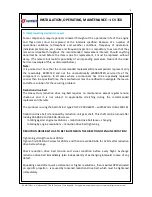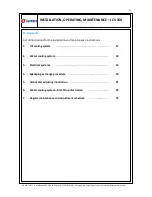
10
INSTALLATION, OPERATING, MAINTENANCE—JCV 360
JCV MOTOR s.r.o. , Vikýřovice 562, 788 13, Šumperk, Czech Republic—Europe, www.vernermotor.com, [email protected]
Hi screw adjusting:
NOTE: THE Hi ADJUSTMENT SCREW WORKS MUCH THE SAME AS THE MIXTURE
CONTROL ON A CERTIFIED AIRCRAFT ENGINE THAT IS USED TO LEAN THE
ENGINE FOR BEST FUEL CONSUMPTION AND POWER. IF AN EGT GAUGE IS
PRESENT IT SHOULD SHOW MAXIMUM TEMPERATURE AT THE MAXIMUM RPM.
-
Tie aircraft down to protect from unexpected movement.
-
Ensure propeller is clear of obstructions.
-
After warmup, apply full throttle and turn Hi screw in or out until you find maximum
power (RPM) setting (you can usually find maximum power setting by tightening Hi screw
from original setting). This will also be the maximum temperature shown on the EGT gauge.
-
Tighten Hi screw (lean the mixture) slowly from maximum rpm position until engine
suddenly looses power (drop of RPM caused by excessive lean mixture).
CAUTION:
Immediately loosen Hi screw to maximum engine power setting (otherwise en-
gine will overheat and be damaged due to excessive lean condition)!
-
Loosen Hi screw for 1/8 of turn from maximal power setting. Never use maximal power
setting! Always open (loose) Hi screw for a bit (make richer mixture). Maximal RPM fall
about 100 RPM (1/8 Hi screw loosing) compared to maximal RPM setting. (The EGT gauge
should show a temperature approximately 100 degrees F less than peak and on the rich side
of peak
).
5. Water cooling system—
first fill up and working principle
WARNING WARNING WARNING:
THIS IS A CRITICAL PROCEDURE
The engine is cooled by liquid flowing through cylinders and cylinder heads. The water
pump, which is located at the back side of the engine, pushes this liquid into the cylinders
and cylinder heads. The thermostat, situated in each cylinder head, opens and redirects the
liquid through the radiator and back into the water pump after heating to a certain level. The
cooling system must be installed in such way that air bubbles from cylinders and cylinder
heads can flow upwards through hose-pipes into the radiator or into the expansion tank.











































